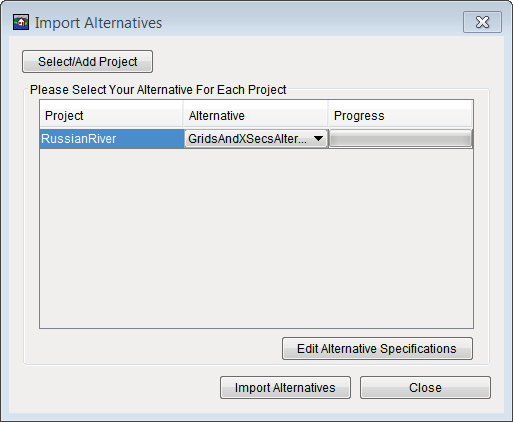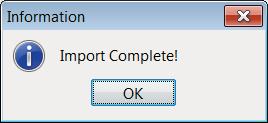For the HEC-FIA import, the HEC-FIA model needs to have been built with HEC-FIA Verison
-
- or later; the import process will not import any EC-FIA models that were built with earlier versions of HEC-FIA.
-
-
- From the HEC-RTS main window (Figure 1.1), click the Setup module, from the Models menu (Figure 6.2), point to Import, click FIA. An Import Alternatives dialog box will open (Figure 6.12).
-
-
- Click Select/Add Project (Figure 6.12), an Open Browser will open (Figure 5.5). From the browser the user will navigate to where the HEC-FIA model is located, select a .prj file, click *Open, the Open Browser will close (Figure 5.5).

Figure 6.12 Import Alternatives Dialog Box
-
-
- The table in the Please Select Your Alternative For Each Project box (Figure 6.12) will list the selected HEC-FIA model. From the Alterative List (Figure 6.12), select the HEC-FIA alternative to be used in the HEC-RTS watershed.
-
-
- Click Import Alternatives (Figure 6.12), the import will start, and in the Progress column of the table (Figure 6.12) a green progress bar will display letting the user know how the import is progressing. An Information message window (Figure 6.13) will display when the HEC-FIA model import is finished, click OK. The Information message window (Figure 6.13) will close.

Figure 6.13 Information Message Window
-
-
- From the Import Alternatives dialog box (Figure 6.12) click Close, the Import Alternatives dialog box will close (Figure 6.12). The user is returned to the HEC-RTS main window (Figure 1.1). From the Watershed Tree (Figure 6.6), from the Models folder, expand FIA, and the list of HEC-FIA alternatives is displayed.
All the models have been imported, the next step is to associate alternatives keys (used in the
F-part of the DSS pathname) with each model's alternatives, and then link the model alternatives together – model integration.
